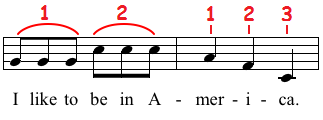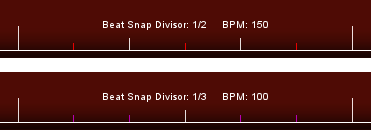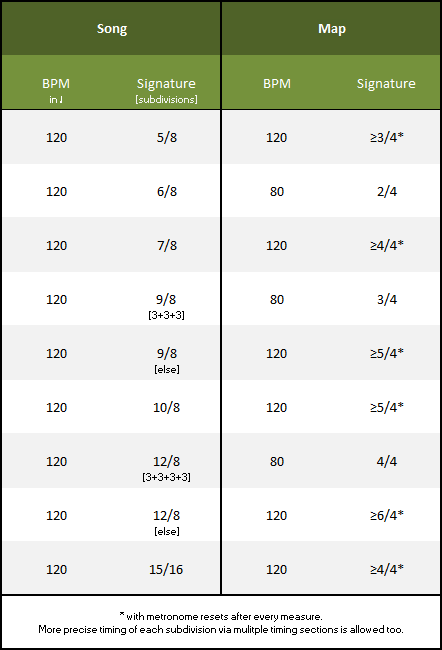Timing songs with #/8-signatures
Every now and then, songs are being mapped that have a time signature that is not divided into quarter-notes (e.g. 3/4, 4/4, 7/4, ...) but into eighth-notes (e.g. 6/8, 7/8, ...). The current editor does not support those #/8-signatures but will in the future.
To make that chart more understandable and state more precisely what is meant, this guide will now explain a bit of the relevant music theory behind this, and give examples of how it translates into osu!. For this reason, three mapsets have been prepared for you to download, which will be used as a reference in this guide.
Music theory
Generally speaking, a measure contains a certain amount of beats. In musical sheet notation, one beat usually equals one quarter-note ♩, and one quarter-note ♩ is divided into two eighth-notes ♪♪. Hence, the term "Beats Per Minute" (BPM) describes the tempo of a song by stating how many quarter-notes ♩ are being played in a minute. In osu!, beats are represented by the white ticks in the timeline, and eighth-notes ♪ are usually represented by red ticks. The start of each measure is indicated by a big white tick.
At least that's how it works for #/4-signatures. The fundamental difference to #/8-signatures is that a beat doesn't always contain just two eighth-notes ♪, it can also contain three ♪s! A good example for this is the difference between 3/4- and 6/8-signature: Both of them contain six ♪s , but while 3/4 splits those into three groups of two (♪♪+♪♪+♪♪, [2+2+2]) by accentuating the first note of each pair, 6/8 splits them into two groups of three (♪♪♪+♪♪♪, [3+3])! These "groups" are also called "subdivisions". Time signatures only containing subdivisions of three eighth-notes ♪ (like in 6/8) are called "compound", time signatures containing subdivisions with variable amounts of eighth-notes ♪ are called "complex" or "irregular" (e.g. 7/8, more on that later). When a certain pattern made up of different time signatures repeats regularly, it is called "mixed meter".

Now to give you a first example of this in osu!, look at the 3/4-difficulty in the provided mapset of Leonard Bernstein's "America" - In this difficulty, I timed everything in 3/4-signature, meaning that every measure is divided into three beats by white ticks. When you turn the BeatSnapDivisor to 1/2, every beat is split into two by the red ticks in the timeline - A red tick representing an eighth-note ♪. This would work perfectly fine for a 3/4-song, but if you listen closely you can hear something special about this song: While the overall tempo stays (approximately) the same, the rhythmical grouping of ♪s switches almost every measure - The first measure of the mapped part at 00:03:662 is split into [3+3], as it has only one more accentuation on the red tick at 00:04:232. The second measure, which starts at 00:04:801 is grouped into [2+2+2], as it has two more accentuations on the white ticks at 00:05:181 and 00:05:561. In other words, all measures are equally long (6♪s), but half of them only have two beats (-> 6/8-measure) while the other half has three beats (-> 3/4-measure), making this a mixed meter! There are different ways to handle this in osu! that all have their up- and downsides, which I will showcase in the next segment.

Methods of timing songs with #/8-signatures
Generally speaking, there are 2 viable methods of dealing with this problem in osu!.
Emulating #/8-signatures
When talking about the 3/4-difficulty in Leonard Bernstein's America, I mentioned that one of the beats lands on a red tick instead of a white tick at 00:04:232 because that measure is split into [3+3], which makes it a 6/8-measure. In order to "fix" where the beat lands, the BPM has to be multiplied with 0,666. Furthermore, the Time Signature shown in the TimingSetupPanel has to be set to 2/4 - This is currently not possible in the editor, but it is allowed to change it in the map's .osu-file. After doing that, the BeatSnapDivisor has to be changed to 1/3 so it splits one beat into three ♪-notes, which are then represented by the purple ticks. The result of this can be seen in the 6/8-difficulty.

For a simpler example, take a look at the provided set of Queen's We Are The Champions, which is a song purely in 6/8-signature. When you look at the timing-tab of the 6/8-difficulty, you can see that the small white ticks in-between the measures land precisely on the song's actual beats, and all the eighth-notes ♪ are mapped by using the 1/3-BeatSnapDivisor.
This method is rhythmically the most accurate in osu!. Since white ticks are always representing a beat, both the pulsating osu!logo in the SongSelectMenu and the Nightcore-soundeffects are always on point and properly convey the song's "feeling". It is very easy and practical to use this method for songs in signatures like 6/8 but also 9/8, 12/8, etc. - Many of those signatures are more common than one might think, for example Nekomata Master - Avalon no Oka is a song in 12/8-signature, which has intuitively been timed as 4/4-signature and mapped by using the 1/3-BeatSnapDivisor. This is why we are generally enforcing this method of timing for all songs in #/8-signatures where the beats are consistently divided into three eighth-notes ♪♪♪ (e.g. it would be enforced on Queen's We Are The Champions, whereas it would not be enforced on Leonard Bernstein's America because it is in mixed meter).
But this method can also cause some problems: First of all, the BeatSnapDivisor does not have as many layers of "triple-snaps" (3,6,12) as it has of "duple-snaps" (2,4,8,16). This can make it impossible to snap potential fast rhythms that might occur in some songs, which you might want to map in higher difficulties.
Secondly, there are more complex #/8-signatures than those that have multiples of 3 in the upper numeral of the signature. For example, while a 6/8-measure is always formed as [3+3], you can get measures with "irregular" beats by combining [2]s and [3]s. For example, a 7/8-measure can be formed as [3+2+2], [2+2+3] or [2+3+2]. If you still want to have the beats timed accurately with white ticks, you'd have to use multiple timing-sections within one measure to follow both the "fast" beats (the [2]s) and the "slow" beats (the [3]s). This can be seen in the 7/8-difficulty of "Le Mystere Des Voix Bulgares - Erghen Diado". As you can see, I had to set two timing-sections per measure (marked with bookmarks), and because of the different BPM-values I also had to change the SV-multiplier of half of the sections. Moving around in this map is rather tedious too, because while all of the mapped notes are equally long, half of them are snapped as 1/2-notes and half of them as 1/3-notes. This is why we are not enforcing this method for songs with complex time signatures (or when rhythms become unsnappable), and allow the alternative method used in the 3.5/4-difficulty.
Treating them as #/4-signatures
This method of timing is generally very simple: ♪-notes are always represented by the red (and white) ticks from the 1/2-divisor. This means that even when the song changes signature, the BPM remains the same and the BeatSnapDivisor doesn't need to be changed to 1/3 in order to map ♪-notes. Navigating in the timeline is easy, and the BPM that is shown in SongSelect and on the website is generally an accurate indicator of the map's usual tapping-speed ("I can singletap / stream 200 BPM" always refers to singletapping red ticks / streaming blue ticks in that tempo). However, for complex time signatures this might not always accurately follow the song's beat, and never accurately follows the beat of compound time signatures - For example, when looking back at the 3/4-difficulty of Queen's "We Are The Champions", you can see that the small white ticks in-between the measures do not land on the song's beats.
This is the go-to-method for timing songs with complex time signatures, as it significantly reduces the timing-effort and ensures easy handling of the timeline. You are always allowed to use the more accurate first method, but only forced to use it when the song's beat-value is consistently three eighth-notes ♪♪♪ (e.g. both of the provided timings for Erghen Diado are acceptable, as it has inconsistent beat-value [2+2+3]). For mixed meters, the start of every measure is required to land on a big white tick. Compound and complex #/2- or #/16-signatures are to be dealt with similarly.
